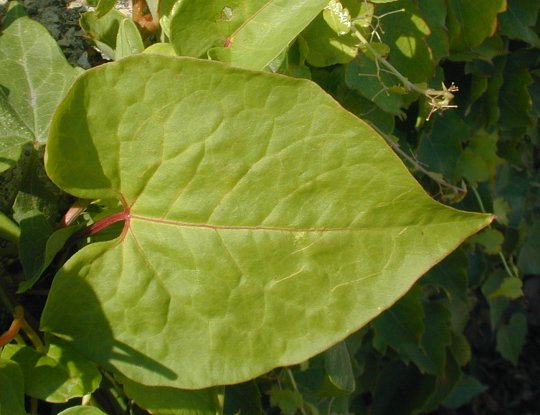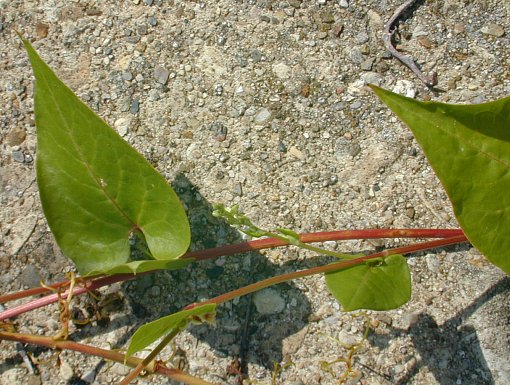Description: This herbaceous perennial plant is a twining vine up to 20' long that can climb adjacent vegetation and fences, otherwise it sprawls across the ground. The slender stems are light green to bright red and round, angular, or slightly ridged. They are largely hairless, except for minute stiff hairs along the ridges. At the base of the petioles, the stems are slightly swollen and have short ocreae (membranous sheaths) that are without bristles. The alternate leaves are up to 4" long and 2" across (excluding the petioles). They are cordate or ovate, smooth along the margins, hairless, and indented at the base. Their slender petioles are up to 1½" long and similar in appearance to the stems. The lower leaves have long petioles, while the smaller upper leaves are nearly sessile. From the axils of the leaves, there develops one or more racemes of flowers about 2-8" long. These racemes are usually more or less erect (although sometimes horizontal) and their central stalks are often terete with numerous fine ridges. The greenish white flowers occur in loose whorls along these racemes. They are initially semi-erect while in bloom, but dangle downward from their slender pedicels while developing their fruits. Each flower is about 1/6" (4 mm.) long, consisting of 5 greenish white tepals, 8 stamens, and an ovary with a tripartite style. The 3 outer tepals are conspicuously winged. The wings of these tepals can be smooth, undulate, or slightly jagged. The blooming period occurs from mid-summer to early fall and lasts about 1-2 months. Each flower is replaced by a winged fruit about 1/3" (8 mm.) long that consists of the 3 outer tepals enclosing a single achene. This fruit is initially greenish white like the flower, but it eventually becomes brown. The 3-angled achenes are about 1/8" (3 mm.) in length (or slightly longer). They are dark brown or black and shiny. The mature fruits can float on water or be blown about by the wind, thereby distributing the achenes. This plant reproduces by reseeding itself and can form sizable colonies at favorable sites.

Cultivation:
The
preference is partial sun, moist to mesic conditions, and a fertile
loamy soil, although full sun, drier conditions, and rocky or gravelly
soil are also tolerated. This vine develops rapidly during the summer
and can smother small shrubs. It is quite aggressive.
Range & Habitat:
The native Climbing Buckwheat is a common plant that occurs in every
county of
Illinois (see Distribution
Map; the distribution of each variety for this species has
been combined). Habitats include open woodlands in floodplain areas,
woodland borders, thickets, riverbanks, ditches, sloping ground along
bridges, and fence rows. This species is often found in moist areas
along the edges of woodlands or near sources of water. It is thrives on
disturbance and is rather weedy, although regular mowing and
cultivation of the soil isn't tolerated because of its perennial habit.

Faunal
Associations:
The nectar and pollen of the flowers attract mostly smaller bees,
wasps, and flies, including Halictid bees, masked bees (Hylaeus spp.),
Andrenid bees, Sphecid wasps, Crabronid wasps, Perilampid wasps, Vespid
wasps, Syrphid flies, flesh flies (Sarcophagidae), and Muscid flies.
Butterflies are less common visitors to the flowers (Robetson, 1929).
Other insects feed destructively on the foliage and other parts of
Climbing Buckwheat (Fallopia scandens) and similar plants. These
species include the Brassy Flea Beetle (Chaetocnema concinna), Knotweed
Leaf Beetle (Gastrophysa polygoni), a leaf-miner beetle (Mantura
floridana), an aphid (Macrosiphum venaefuscae), seed-eating larvae of a
case-bearer moth (Coleophora borea), and larvae of a Geometer moth, the
Cross-lined Wave (Timandra amaturaria); see Eiseman (2016), Clark et
al. (2004), Marcovitch (1916), Blackman & Eastop (2013), Braun
(1921), and Wagner (2005). The large seeds of this plant are an
important source of food to many birds, especially upland gamebirds and
some songbirds (see Bird Table). The seeds of Climbing Buckwheat are
also eaten by some mammals, such as the White-footed Mouse, Deer Mouse,
and American Black Bear (Hamilton, 1941; Romain et al., 2013). The
dense foliage of this luxuriant vine provides excellent cover for
various mammals and habitat for nesting birds.
Photographic Location:
Along a bridge in Urbana, Illinois.

Comments: This is a luxuriant vine that can smother everything in its path. However, the flowers and fruits are produced in abundance and are rather showy. There is a lack of consensus regarding the taxonomy of this variable species. Some botanists (the 'splitters') divide Fallopia scandens (Climbing Buckwheat) into 2 or 3 species, while others (the 'lumpers') recognize only a single species with different varieties. Similar to Yatskievych (2000), I prefer the taxonomy of the latter and regard Fallopia cristata (Crested Climbing Buckwheat) as a variety of Climbing Buckwheat, or Fallopia scandens cristata, as specimen plants tend to intergrade. However, according to Mohlenbrock (2002), Climbing Buckwheat has winged fruits that exceed 10 mm. in length, while the winged fruits of Crested Buckwheat are shorter. An older scientific name of Climbing Buckwheat is Polygonum scandens, while Crested Climbing Buckwheat has been referred to as Polygonum cristatum and Polygonum scandens cristatum. Another species in this genus, Fallopia convolvulus (Black Bindweed), is an adventive annual vine from Europe that is up to 6' long. The flowers and fruits of Black Bindweed are keeled, rather than conspicuously winged, and the sides of its 3-angled achenes are dull, rather than shiny.